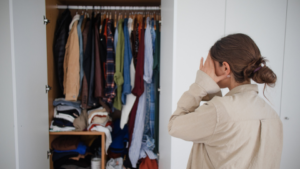Just say NO!
If you’ve read my Swedish Death Cleaning article (or watched my video on Youtube), you might have already started on your journey to less stuff. Perhaps you’ve been consciously de-cluttering and evaluating the items in your home. Maybe you’ve donated, sold, or otherwise disposed of a large portion of your possessions and you’ve started to see the benefits already. Your home is looking better, you’re much less stressed, you’re letting go of the things that have been holding you back. But wait. There’s something else happening.
Very slowly, almost imperceptibly, and maybe even mysteriously, there’s another pile of stuff growing! Suddenly things don’t seem to be reducing as fast as they did when you first started de-cluttering. So what’s going on here? You’ve got a case of Unconscious Accumulation. And I might just be able to help with that.
Old habits can be hard to break, and that applies to the way we view possessions including the value we place on acquiring them. It’s often ingrained in us in our formative years, for example: if you grew up in an environment of scarcity, then you’re more likely to want more stuff around you and to acquire even more stuff whenever the opportunity arises. This is understandable and not in any way “wrong”, but it can be helpful to recognise it if you are endeavouring to minimise your lifestyle.
If you find the volume of stuff coming into your life is matching (or even exceeding!) the volume that is leaving, then you may want to consider the causes. Often just observing your own patterns of behaviour is enough, but I’d like to offer some practical actions you can take as well.
In this article I’ve compiled a list of TEN tips that might help you stop accumulating and get you back on track on your de-cluttering journey. And if you read until the end, I’ll give you a bonus tip that has really helped me in my own personal journey…..and it’s all about emotions.

Tip #1: – Think
When considering adding something new to your household, take a moment to stop and think about it by asking yourself some questions. I’ll go into these in more depth later on.
- Do I really need this? Or is there an item I already own that has the same function? Often items will serve a number of purposes, so check this first. For example, I had three kitchen appliances at one stage that were all capable of blending. I kept the one that could blend but also had the most functions.
- Where will it go? Is there room to store it? This is valid particularly for larger items. It’s tempting to “make room” for something, but then if you’re doing that, do you really need it in the first place?
- How often will I use it? Is it something I need to use every day, once a week, or once a year? If it’s something you use very infrequently then consider borrowing or renting that item for the rare occasions you will need it.
- Do I already have similar? Check your inventory for that item. You might even already have the identical thing. This is more likely to happen if you’ve just started decluttering and still don’t know exactly what you have. Trust me, it’s happened a few times to me!
Tip #2: – Learn to say NO.
This is a hard one for some people (including me). I’m a people pleaser and feel that I will deeply offend somebody if I say no. I am getting better with age, but it does still take effort to refuse. I’m talking specifically here about people giving you their items to store or take on.
There are three scenarios I’m going to talk about here:
Scenario #1: when somebody is doing their own decluttering.
They might want to give you practical possessions, sentimental keepsakes, even furniture. In this case, refusal is quite easy. Tell them that they are kind to think of you, but explain that you’re on a de-cluttering journey of your own and will not be taking in anything. You can even exchange tips on your progress and perhaps share some handy videos (like mine!).
Scenario #2: when a loved one dies and household possessions are being divided.
Again, it’s OK to refuse. I understand that this is a little harder because there are emotions involved. You can explain that you have cherished memories of that person that exist beyond the physical possessions they had. Everybody’s memories are personal, so it’s inappropriate for someone to tell you how you should remember someone. In the case of photographs, you can take those and digitise them (this is also a great way for everyone to have copies if they want them).
In fact, thinking about this scenario is good motivation for Swedish Death Cleaning, because I know I don’t want to think about my family having to sort through mountains of my stuff after I’m gone.
Scenario #3: there’s a family member (often one of your kids) who wants to store things at your house.
They don’t live with you anymore, but they’re either in a transient time of their lives or living in a very small apartment. This is a perfect time to preach the value of minimalism! Encourage them to scrutinise their own possessions and reduce their inventory. If they can’t live with their stuff then they probably have too much and a good place to start is for them to look at exactly what they want to store with you. Obviously they are things they don’t need on a regular basis and it might just be nostalgia. Encourage them to have a good look at it before deciding if it’s worth spending money on a storage unit
Tip #3: – Gifts
Ah gifts! I think this is one of the toughest parts of de-cluttering. The guilt, the obligation, the awkwardness. Let’s see if we can sort this one out.
Firstly, and most importantly, lay the ground work for avoiding this awkward gifting situation in the first place. Be sure to make it clear to your family and friends that you are in the de-cluttering phase of your life and would appreciate it if there were no physical gifts. This doesn’t mean no gifts at all, just alternatives like gifted experiences, kind deeds, consumables (like food or wine), or charity donations. This can be done politely by saying something like “it would mean a lot to me if you could make me my favourite cake instead of buying me a gift this year”. Also, make it clear on any invitations: “No gifts”. If you like, you can provide the name of a charity that they could donate to on your behalf, but in most cases those two words will be enough.
But what happens if, despite all of this, somebody gives you a gift? Well you have two options: refuse it or accept it and there are conflicting thoughts on those!
Refusal: I personally don’t believe there is a good way to politely refuse a gift. You may disagree with me here and if so please do tell me your thoughts in the comments. The best way I can think of is to say something like “You are so kind to think of me and I really appreciate the gesture, but I just can’t accept it right now. Thank you.” I don’t think any further explanation is necessary or helpful. I still think that would offend the giver though.
So, you could just accept the gift. That person went to the trouble of thinking of you and what you might like, then getting it for you. Somebody in the Swedish Death Cleaning video made a comment that your obligation to that gift (and the giver) ends when you thank them for the gift and I guess that’s true. In other words you’re not obligated to keep the gift. So perhaps you keep it for a while and then donate it? Or maybe you return it? I don’t think that the person giving you the gift would want you to feel guilty about it, but I guess you’d have to consider the motivation for the gift too. I don’t know, it’s a tricky social situation and I’m Autistic so I don’t get social situations at the best of times! Let me know in the comments and I reckon we could work this out together.
In fact, I have thoughts on Gift Culture too and I’m currently working on an article all about it. Stay tuned.
Tip #4: Online shopping
I’m addressing online vs bricks and mortar because I feel this is more of an impulse buying danger and can lead to purchasing unnecessary items. So here are some online shopping tips:
- Unsubscribe from marketing emails. These may tempt you into clicking on an item you wouldn’t normally need because it looks so good in the email. In fact, that’s the whole job of those emails! Just click the unsubscribe button down the bottom of the email and enjoy a more uncluttered inbox at the same time.
- Use a wish list or watch list. Instead of immediately purchasing an item, add it to a wish list. Most websites will have this feature (it might also be called my favourites). It’s kind of like shopping but you don’t actually end up buying anything. Then, I like to go back and look at my wish list from time to time and I inevitably find that I’ve cooled on some items and actually don’t want them anymore.
- Delay checkout. If you go beyond the wish list and you really want to buy some items, just add them to your cart but don’t check out immediately. Give it a day or two. An added benefit to this is that you may get an email from the retailer giving you a discount if you check out. Who doesn’t love a discount?
Tip #5: Challenge yourself to a “No buy” time period
This doesn’t have to be a huge time period. Start with a week, then go to a month, a season, and ultimately aim for the No Buy Year.
What does this mean? Well, it’s a period of time in which you set yourself the goal to not buy anything new. This excludes groceries and basic necessities in your life, as well as replacing broken items that can’t be repaired. But what it does include are new clothes, new makeup or skincare (unless you’ve used everything up), new books, new gadgets, decorative home décor items, handbags, shoes, or anything you don’t actually need. It’s really about need vs want.
This can be a difficult goal, which is why it’s best to start small. Try marking the days on a calendar where you didn’t buy anything. This will give you a visual of your progress. You could even set yourself small challenges, like if I make it to the end of this week, I’ll treat myself to a nice dinner out. Hang in there and gradually your mind-set will begin to change and it WILL become easier.

Tip #6: Repair
If you have broken items around the house, consider if they can repaired. Sometimes you will need to take them to an expert in that field – for example if it is an electrical item. You might also know somebody who is good at repairing things. And many times (more than you might think), you will be capable of fixing things yourself. All it takes is a bit of imagination and Youtube! If you do a search, you will find lots of videos on repairing various items.
One example is my washing bucket. This is the bucket I use to take the clothes out of the washing machine and then take them to hang on the line. One of the handles had split and I considered throwing it away and buying a new one, but my Dad actually saw that it was broken and so he repaired it. Guess what he used. An old section of garden hose! He just glued it the handle base on either side and it was perfectly functional again. It didn’t look pretty, but it’s just a washing bucket and who cares what it looks like?
It’s fun thinking of inventive ways to repair things and I’d love to hear in the comments what methods you’ve used to fix something you were going to replace.
Tip #7: Borrowing
If you need an item but it’s just for a specific job that you’re only going to do once, then see if you can borrow it.
For example, I needed to strip some wallpaper in my house and thought about buying a wallpaper steamer. Before I purchased it, I thought I would ask my Facebook friends to see if anybody had one already. Luckily one of my friends who lived close by offered hers, so I went and picked it up, used it for a couple of days, then returned it to her all cleaned and with a nice plate of home-baked cookies as a thank you.
There are also services that offer items for rent: these include tools, appliances, garden maintenance supplies, cleaning machines, toys and even clothing. Then of course there are libraries where you can get any book you want for free. Don’t you just love libraries?
Remember to be a good borrower. Return items on time, in good condition (maybe even better than what they were), and if the item was from a friend, think about giving a small gift of gratitude. That way, people will be more inclined to lend you things when you need them in the future.
Tip #8: pay for it
I don’t just mean with money! If you really must acquire something new, make a rule for yourself that for every new item that comes into your house, three old items must leave. This means that you need to actively go through the items in your house and select three things to donate/sell/dispose of to compensate for the one new item that is coming in. This will give you a net reduction of two in your inventory, and if you’re feeling really ambitious you can increase the number of leaving items to five or more and enjoy a bigger overall reduction. This is a good way of making sure that your inventory is definitely not increasing, in fact you’re progressing on your de-cluttering journey all the time.
Tip #9: Repurpose
Do you need an item to do a specific task? Maybe you already have something that can do the same job. I’ll use my washing bucket again as an example. I use this for putting my washed clothes into, but also for hand-washing delicate items, as a temporary receptacle for de-cluttered items, a carry-all for the beach, even a shopping basket. Other examples are: kitchen appliances that can perform multiple tasks, a baking dish that is suitable to use as a serving dish too, I use my fruit basket as a bread basket at dinner parties (having taken the fruit out first of course), and I even fold a pretty sheet and use it as a table runner when we have guests.
You can also use old items to perform a totally new task, for example an old toothbrush can be a great cleaning brush for hard to reach places in the bathroom, or use glass jars for tidying and storing items, worn tights can make great dusters, and old pillow cases can be used as garment covers in your wardrobe (just cut a hole in them and slip them over the hanger).

Tip #10: Buying repeat items
Sometimes you buy something and when you get it home, you realise you already have that exact item. This can happen because you’re not very far along on your de-cluttering journey and you’re actually not aware of everything in your possession. You have so much stuff that you forget what’s there. Don’t worry, this will get better, but in the meantime, try and ask yourself the questions in tip #1. This can also happen with items that you’ve already gotten rid of. You’ve determined that you don’t need it and realised that you don’t use it, but you’ve bought it back again…..only to not use it again!
It’s a frustrating cycle. I didn’t even know I was doing this until I started on the Swedish Death cleaning journey. It might help to look at the items you are duplicating and think about why you keep buying them and not using them. Are they aspirational for you in some way? In other words, do they fit an image of your life that you aspire to but realistically it doesn’t suit your actual lifestyle. For example, I used to keep buying high heeled shoes, thinking I will wear them to some fancy outing but then I ended up donating them because I find those types of shoes really uncomfortable and will always choose something else when the time comes.
Well you’ve read this far and I thank you for sticking with me. As a little reward here’s a bonus tip that has helped me to stop accumulating and maybe it will help you too.

Bonus tip: How are you feeling?
I’ve noticed that the times I’ve bought new items coincide with certain emotional states. With me, it’s particularly prominent when I’m feeling insecure. It could be insecurity about my appearance, or my home, or whether I’m feeling like a capable person, but either way it leads to shopping!
Next time you find yourself reaching for your credit card, notice how you’re feeling. Are you sad, anxious, insecure, or even particularly joyful? You might be able to identify a pattern in your shopping habits and maybe figure out a way to avoid purchasing anything when you’re in a certain emotional state.

So what do you think? Have you found yourself Unconsciously Accumulating? And if so, have any of these tips been helpful? Which one can you put into action today?
Remember, we’re all different and there is nothing wrong with you if you like to have a large number of possessions. If this is making you happy and you can afford to live like this, then carry on. You do you. You’re doing great!
I want to make it clear that I’m not telling you what you should be doing. I’m simply offering another perspective and chances are, if you’re reading this article, you’ve been feeling the need to de-clutter and simplify your life too.
For me personally, it’s been transformative. It’s made me less stressed. I’m a much happier person, I appreciate what I have, and I’ve really started to understand what’s important to me (hint: it’s not “stuff”). For me, having less has been freeing in more profound ways than just freeing up space. I want to share that feeling with others and make a positive difference in someone’s life.








